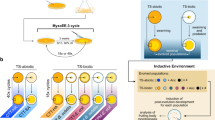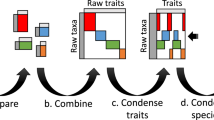Abstract
Functional morphological adaptation is an implicit assumption across many ecological studies. However, despite a few pioneering attempts to link bacterial form and function, functional morphology is largely unstudied in prokaryotes. One intriguing candidate for analysis is bacterial shape, as multiple lines of theory indicate that cell shape and motility should be strongly correlated. Here we present a large-scale use of modern phylogenetic comparative methods to explore this relationship across 325 species of the phylum Firmicutes. In contrast to clear predictions from theory, we show that cell shape and motility are not coupled, and that transitions to and from flagellar motility are common and strongly associated with lifestyle (free-living or host-associated). We find no association between shape and lifestyle, and contrary to recent evidence, no indication that shape is associated with pathogenicity. Our results suggest that the independent evolution of shape and motility in this group might allow a greater evolutionary flexibility.
This is a preview of subscription content, access via your institution
Access options
Subscribe to this journal
Receive 12 digital issues and online access to articles
$119.00 per year
only $9.92 per issue
Buy this article
- Purchase on Springer Link
- Instant access to full article PDF
Prices may be subject to local taxes which are calculated during checkout

Similar content being viewed by others
References
Díaz, S. et al. The global spectrum of plant form and function. Nature 529, 167–171 (2016).
Hale, M. S. & Mitchell, J. G. Functional morphology of diatom frustule microstructures: hydrodynamic control of brownian particle diffusion and advection. Aquat. Microb. Ecol. 24, 287–295 (2001).
Wainwright, P. C. Functional versus morphological diversity in macroevolution. Annu. Rev. Ecol. Evol. Syst. 38, 381–401 (2007).
Martiny, J. B. H., Jones, S. E., Lennon, J. T. & Martiny, A. C. Microbiomes in light of traits: a phylogenetic perspective. Science 350, aac9323 (2015).
Dusenbery, D. B. Living at Micro Scale: The Unexpected Physics of Being Small (Harvard Univ. Press, 2009).
Persat, A., Stone, H. A. & Gitai, Z. The curved shape of Caulobacter–crescentus enhances surface colonization in flow. Nat. Commun. 5, 3824 (2014).
Young, K. D. The selective value of bacterial shape. Microbiol. Mol. Biol. Rev. 70, 660–703 (2006).
Young, K. D. Bacterial morphology: why have different shapes? Curr. Opin. Microbiol. 10, 596–600 (2007).
Mitchell, J. G. The energetics and scaling of search strategies in bacteria. Am. Nat. 160, 727–740 (2002).
Cooper, S. & Denny, M. W. A conjecture on the relationship of bacterial shape to motility in rod-shaped bacteria. FEMS Microbiol. Lett. 148, 227–231 (1997).
Dusenbery, D. B. Fitness landscapes for effects of shape on chemotaxis and other behaviors of bacteria. J. Bacteriol. 180, 5978–5983 (1998).
Ramos, H. C., Rumbo, M. & Sirard, J. C. Bacterial flagellins: mediators of pathogenicity and host immune responses in mucosa. Trends Microbiol. 12, 509–517 (2004).
Cullender, T. C. et al. Innate and adaptive immunity interact to quench microbiome flagellar motility in the gut. Cell Host Microbe 14, 571–581 (2013).
Lovewell, R. R. et al. Step-wise loss of bacterial flagellar torsion confers progressive phagocytic evasion. PLoS Pathog. 7, (2011).
Patankar, Y. R. et al. Flagellar motility is a key determinant of the magnitude of the inflammasome response to Pseudomonas aeruginosa. Infect. Immun. 81, 2043–2052 (2013).
Chaban, B., Hughes, H. V. & Beeby, M. The flagellum in bacterial pathogens: for motility and a whole lot more. Semin. Cell Dev. Biol. 46, 91–103 (2015).
Dalia, A. B. & Weiser, J. N. Minimization of bacterial size allows for complement evasion and is overcome by the agglutinating effect of antibody. Cell Host Microbe 10, 486–496 (2011).
Frirdich, E. & Gaynor, E. C. Peptidoglycan hydrolases, bacterial shape, and pathogenesis. Curr. Opin. Microbiol. 16, 767–778 (2013).
Sycuro, L. K. et al. Multiple peptidoglycan modification networks modulate Helicobacter–pylori’s cell shape, motility, and colonization potential. PLoS Pathog. 8, e1002603 (2012).
Champion, J. A. & Mitragotri, S . Role of target geometry in phagocytosis. Proc. Natl Acad. Sci. USA 103, 4930–4934 (2006).
Doshi, N. & Mitragotri, S. Macrophages recognize size and shape of their targets. PLoS ONE 5, e10051 (2010).
Veyrier, F. J. et al. Common cell shape evolution of two nasopharyngeal pathogens. PLoS Genet. 11, e1005338 (2015).
Stackebrandt, E. & Woese, C. R. A phylogenetic dissection of the family micrococcaceae. Curr. Microbiol. 2, 317–322 (1979).
Siefert, J. L. & Fox, G. E. Phylogenetic mapping of bacterial morphology. Microbiology 144, 2803–2808 (1998).
Tamames, J., González-Moreno, M., Mingorance, J., Valencia, A. & Vicente, M . Bringing gene order into bacterial shape. Trends Genet. 17, 124–126 (2001).
Ley, R., Turnbaugh, P., Klein, S. & Gordon, J. Microbial ecology: human gut microbes associated with obesity. Nature 444, 1022–1023 (2006).
Wrighton, K. C. et al. A novel ecological role of the Firmicutes identified in thermophilic microbial fuel cells. ISME J. 2, 1146–1156 (2008).
Sharmin, F., Wakelin, S., Huygens, F. & Hargreaves, M. Firmicutes dominate the bacterial taxa within sugar-cane processing plants. Sci. Rep. 3, 3107 (2013).
Hadfield, J. D. MCMC methods for multi-response generalized linear mixed models: the MCMCglmm R package. J. Stat. Softw. 33, 1–22 (2010).
Maddison, W. P. & FitzJohn, R. G. The unsolved challenge to phylogenetic correlation tests for categorical characters. Syst. Biol. 64, 127–136 (2015).
Pagel, M. Detecting correlated evolution on phylogenies: a general method for the comparative analysis of discrete characters. Proc. R. Soc. Lond. B 255, 37–45 (1994).
Taylor, T. B. et al. Evolutionary resurrection of flagellar motility via rewiring of the nitrogen regulation system. Science 347, 1014–1017 (2015).
Chiara, M. et al. Comparative genomics of Listeria sensu lato: genus-wide differences in evolutionary dynamics and the progressive gain of complex, potentially pathogenicity-related traits through lateral gene transfer. Genome Biol. Evol. 7, 2154–2172 (2015).
Cousin, F. J. et al. Detection and genomic characterization of motility in Lactobacillus curvatus: confirmation of motility in a species outside the Lactobacillus salivarius clade. Appl. Environ. Microbiol. 81, 1297–1308 (2015).
Palmer, K. L., Schaik, W. Van, Willems, R. J. L. & Gilmore, M. S. in Enterococci: From Commensals to Leading Causes of Drug Resistant Infection (eds Gilmore, M. S. et al.) (2014); https://www.ncbi.nlm.nih.gov/books/NBK190425/.
Mendes-Soares, H., Suzuki, H., Hickey, R. J. & Forneya, L. J. Comparative functional genomics of Lactobacillus spp. reveals possible mechanisms for specialization of vaginal lactobacilli to their environment. J. Bacteriol. 196, 1458–1470 (2014).
Poggio, S. et al. A complete set of flagellar genes acquired by horizontal transfer coexists with the endogenous flagellar system in Rhodobacter sphaeroides. J. Bacteriol. 189, 3208–3216 (2007).
Shah, N. et al. Reductive evolution and the loss of PDC/PAS domains from the genus Staphylococcus. BMC Genomics 14, 524 (2013).
Koch, A. L. Were Gram-positive rods the first bacteria? Trends Microbiol. 11, 166–170 (2003).
Errington, J. L-form bacteria, cell walls and the origins of life. Open Biol. 3, 120143 (2013).
Martiny, A. C., Treseder, K. & Pusch, G. Phylogenetic conservatism of functional traits in microorganisms. ISME J. 7, 830–838 (2013).
Li, L. et al. Leaf economics and hydraulic traits are decoupled in five species-rich tropical-subtropical forests. Ecol. Lett. 18, 899–906 (2015).
Pagel, M. in Phylogenetics and Ecology (eds Eggleton, P. & Richard, V.-W. ) 29–51 (Linnean Society Symposium Series, 1994).
Chang, F. & Huang, K. C. How and why cells grow as rods. BMC Biol. 12, 54 (2014).
Jiang, C., Caccamo, P. D. & Brun, Y. V. Mechanisms of bacterial morphogenesis: Evolutionary cell biology approaches provide new insights. BioEssays 37, 413–425 (2015).
Randich, A. M. & Brun, Y. V. Molecular mechanisms for the evolution of bacterial morphologies and growth modes. Front. Microbiol. 6, 580 (2015).
Dworkin, J. Form equals function? Bacterial shape and its consequences for pathogenesis. Mol. Microbiol. 78, 792–795 (2010).
Bonner, J. T. Randomness in Evolution (Princeton Univ. Press, 2013).
Chai, J., Kora, G., Ahn, T.-H., Hyatt, D. & Pan, C. Functional phylogenomics analysis of bacteria and archaea using consistent genome annotation with UniFam. BMC Evol. Biol. 14, 1–13 (2014).
Vos, P. et al. Bergey’s Manual of Systematic Bacteriology Vol. 3 (Springer, 2009).
Pagel, M., Meade, A. & Barker, D. Bayesian estimation of ancestral character states on phylogenies. Syst. Biol. 53, 673–684 (2004).
de Villemereuil, P., Gimenez, O. & Doligez, B. Comparing parent–offspring regression with frequentist and Bayesian animal models to estimate heritability in wild populations: a simulation study for Gaussian and binary traits. Methods Ecol. Evol. 4, 260–275 (2013).
Benjamini, Y. & Hochberg, Y. Controlling the false discovery rate: a practical and powerful approach to multiple testing. J. R. Stat. Soc. Ser. B Stat. Methodol. 57, 289–300 (1995).
Pagel, M. Inferring the historical patterns of biological evolution. Nature 401, 877–884 (1999).
Hadfield, J. D. & Nakagawa, S. General quantitative genetic methods for comparative biology: phylogenies, taxonomies and multi-trait models for continuous and categorical characters. J. Evol. Biol. 23, 494–508 (2010).
Kass, R. E. & Raftery, A. E. Bayes Factors. J. Am. Stat. Assoc. 90, 773–795 (1995).
Acknowledgements
We thank M. Pagel, O. Guadayol Roig, R. Schuech, J. Baker and A. Meade for helpful comments and advice. This work is financially supported by The Leverhulme Trust project RLA RL-2012-022, ‘Form and function in a microbial world’, granted to S.H. C.V. was supported by a Leverhulme Trust Research Project Grant (RPG-2013-185).
Author information
Authors and Affiliations
Contributions
S.H., C.V. and F.E.B. designed the study; F.E.B. and S.H. developed the protocol for the data collection; F.E.B. collected the data and F.E.B., C.V. and S.H. analysed the data; F.E.B. wrote the first draft of the manuscript, and all authors contributed substantially to revisions.
Corresponding author
Ethics declarations
Competing interests
The authors declare no competing financial interests.
Supplementary information
Supplementary information
Supplementary Figures 1–6; Supplementary Tables 1–3. (PDF 936 kb)
Supplementary phylogenetic tree
Phylogenetic tree of 325 Firmicutes species in Newick format. (TXT 17 kb)
Rights and permissions
About this article
Cite this article
El Baidouri, F., Venditti, C. & Humphries, S. Independent evolution of shape and motility allows evolutionary flexibility in Firmicutes bacteria. Nat Ecol Evol 1, 0009 (2017). https://doi.org/10.1038/s41559-016-0009
Received:
Accepted:
Published:
DOI: https://doi.org/10.1038/s41559-016-0009
This article is cited by
-
Green Waste Compost Impacts Microbial Functions Related to Carbohydrate Use and Active Dispersal in Plant Pathogen-Infested Soil
Microbial Ecology (2024)
-
Core microbes closely related with the nutrients and flavor of sweet fermented oats (whole grain food) from China
World Journal of Microbiology and Biotechnology (2023)
-
The metabolic network of the last bacterial common ancestor
Communications Biology (2021)



